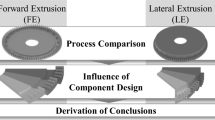Abstract
Sheet bulk metal forming processes have been widely developed to the facilitate manufacture of complicated 3D parts. However, there is still not enough know-how available. In this paper, as one of the typical sheet bulk metal forming processes, the sheet metal extrusion process was studied. A reasonable finite element method (FEM) model of sheet metal extrusion process taking the influence of flow-stress curve with wide range of plastic strain and ductile damage into consideration was established and simulated by an arbitrary Lagrangian-Eulerian (ALE) FEM implemented in MSC. Marc. Validated by comparing the results with experiment, some phenomenological characteristics, such as metal flow behavior, shrinkage cavity, and the influence of different combinations of diameter of punch, diameter of extrusion outlet, and diameter of pre-punched hole were analyzed and concluded, which can be used as theoretical fundamental for the design of the sheet metal extrusion process.
Similar content being viewed by others
References
R. A. Schmidt, F. Birzer, P. Hofel, M. Hellmann, B. Reh, H. Hoffmann. Cold Forming and Fineblanking, A Handbook on Cold Processing, Steel Material Properties, Part Design, Switzerland: Carl Hanser Verlag, pp. 65–116, 2007.
P. F. Zheng, L. C. Chan, T. C. Lee. Numerical analysis of the sheet metal extrusion process. Finite Elements in Analysis and Design, vol. 42, no. 3, pp. 189–207, 2005.
Z. H. Chen, C. Y. Tang, L. C. Chan, T. C. Lee. Simulation of the sheet metal extrusion process by the enhanced assumed strain finite element method. Journal of Materials Processing Technology, vol. 91, no. 1–3, pp. 250–256, 1999.
Z. H. Chen, T. C. Lee, C. Y. Tang. Numerical simulation of a sheet metal extrusion process by using thermal-mechanical coupling EAS FEM. Journal of University of Science and Technology Beijing, vol. 9, no. 5, pp. 378–382, 2002.
X. C. Zhuang, Z. Zhao, H. Xiang. Simulation of sheet metal extrusion processes with arbitrary Lagrangian-Eulerian method. Transactions of Nonferrous Metals Society of China, vol. 18, no. 5, pp. 1172–1176, 2008.
H. Y. Li, X. C. Zhuang, Z. Zhao. Research on material flow stress models in common use. Die and Mould Technology, no. 5, pp. 1–4, 2009. (in Chinese)
P. Hora. Advanced constitutive models as precondition for an accurate FEM-simulation in forming applications. In Proceedings of the 5th German LS-DYNA Forum, Ulm, Germany, 2006.
P. J. McAllen, P. Phelan. Comparison of ductile failure models using a simple elastic-plastic based degradation model. Journal of Materials Processing Technology, vol. 155–156, pp. 1214–1219, 2004.
J. R. Rice, D. M. Tracey. On the ductile enlargement of voids on triaxial stress fields. Journal of Mechanics and Physics of Solids, vol. 17, no. 3, pp. 201–217, 1969.
Z. Zhao, X. C. Zhuang, X. L. Xie. An improved ductile fracture criterion for fine-blanking process. Journal of Shanghai Jiaotong University (Science), vol. 13, no. 6, pp. 702–706, 2008.
F. Cen, T. Xing, K. T. Wu. Real-time performance evaluation of line topology switched Ethernet. International Journal of Automation and Computing, vol. 5, no. 4, pp. 376–380, 2008.
Z. P. Lin, S. S. Xie, J. Chen. Experimental Method for Metal Plastic Forming, Beijing, PRC: Metallurgy Industry Press, pp. 33–40, 2002. (in Chinese)
Author information
Authors and Affiliations
Corresponding author
Additional information
This work was supported by National Science & Technology Major Project of China (No. 2009ZX04014-073) and National Natural Science Foundation of China (No. 50975175).
Xin-Cun Zhuang received the B. Sc. and Ph.D. degrees in materials processing engineering from Shanghai Jiao Tong University, PRC in 2002 and 2008, respectively. Currently, he is a lecturer in the Department of Plasticity Technology at Shanghai Jiao Tong University.
His research interests include sheet bulk metal forming, numerical simulation method, and process optimization.
Hua Xiang received the B. Sc. and M. Sc. degrees in materials science and engineering from Central South Universality, PRC in 2000 and 2003, respectively. Currently, he is an engineer in the Department of Plasticity Technology at Shanghai Jiao Tong University, PRC, and continues to study for Ph. D. degree in material processing engineering.
His research interests include knowledgebased engineering, fineblanking, and sheet bulk metal forming.
Zhen Zhao received the B. Sc., M. Sc., and Ph.D. degrees in materials processing engineering from Shanghai Jiao Tong University, PRC in 1994, 1999, and 2002, respectively. Currently, he is a professor in the Department of Plasticity Technology at Shanghai Jiao Tong University.
His research interests include precision metal forming technology and intelligent design technology.
Rights and permissions
About this article
Cite this article
Zhuang, XC., Xiang, H. & Zhao, Z. Analysis of sheet metal extrusion process using finite element method. Int. J. Autom. Comput. 7, 295–302 (2010). https://doi.org/10.1007/s11633-010-0506-8
Received:
Revised:
Published:
Issue Date:
DOI: https://doi.org/10.1007/s11633-010-0506-8




